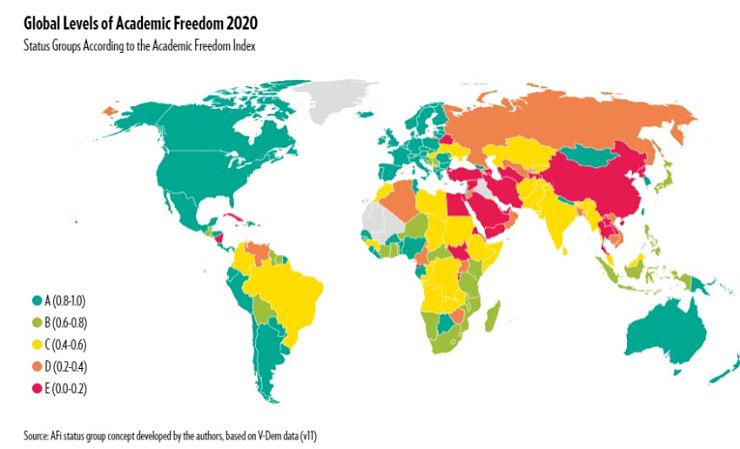Report: Putting the Academic Freedom Index into Action

“Free Universities: Putting the Academic Freedom Index Into Action,” a report released by the Global Public Policy Institute in March, works as part of an effort to put the Academic Freedom Index (AFi) into action. “While states and universities throughout the world have long committed to respecting and protecting academic freedom,” the authors write in the report’s introduction, “it remains poorly understood – and is under attack in many places.”
This second iteration of the AFi data draws on contributions from around 2,000 country experts and covers 175 countries and territories, up from the 144 previously included in the first edition. The AFi covers a period from 1900 to 2020. Taking the long view, “All the indicators suggest a substantial global drop in levels of academic freedom during World War II and a steep overall increase with the third wave of democratization in the early 1990s.” Nonetheless, six countries – such as Turkey, Brazil and Colombia – have seen substantial deterioration in the last five years on the academic freedom measures covered by the index. (Five, albeit with much smaller populations, have seen substantial improvement in the same period.)
The AFi is a ‘robust instrument for research’ and also serves to inform policy debates. The authors – Katrin Kinzelbach, Ilyas Saliba, Janika Spannagel, and Robert Quinn – offer specific recommendations for government officials, parliamentarians, academics, and other key stakeholders on how to apply the AFi to protect and promote academic freedom.
Firstly, the report indicates that AFi country scores can be used to improve established university rankings. It argues that should academic freedom levels feature in the calculations of university rankings, they would help to reduce the number of universities in top tier spaces with restrictive environments. As such, AFi country scores can help to change the knowledge economy and offer new incentives to protect academic freedoms. Additionally, AFi insights can better assist advocacy and professional organizations in supporting their demands and informing their arguments in campaigns.
Conversely, higher education policy-makers should also know to respond to changing AFi scores. For instance, the report urges the EHEA to intensify its information-gathering efforts by ordering assessments of the national higher education sectors in consideration. On an international scale, AFi information can help diplomatic representatives at the UN in reporting on their countries’ record on academic freedom. This would better strengthen their adherence to international human rights laws. AFi can also help national parliaments improve the quality and competitiveness of their higher education and be used to help compare a state’s academic performance with other peer states. This can then help identify opportunities for improvement and growth.
Finally, another recommendation offered in the report states that AFi scores can help advocacy groups to push university leaders and administrators engaged in international higher education activities to understand the conditions in the various countries that they are involved in. These are just some of several recommendations on the usefulness of AFi scores in supporting academic communities, policymakers, university ranking systems, and more.
The report offers a detailed account of its dataset and methodology too. The Academic Freedom Index is made up of five expert-coded indicators that capture 1. Freedom to research and teach, 2. Freedom of academic exchange and dissemination, 3. Institutional autonomy, 4. Campus integrity and 5. Freedom of academic and cultural expression. Approximately 2,000 academic experts contributed to the assessments. Within the dataset, the index is complemented by additional, factual indicators that assess a state’s de jure commitments to academic freedom at constitutional and international levels. It also assesses whether universities have ever existed in any given country.
You can view the full report and a methodological working paper.































































































